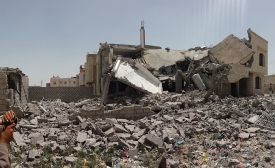ceasefire

The media is failing to tell the full story, and that's part of the problem.
As the country's five-decade war winds down, how the government disarms female fighters could define the coming truce. After 50-plus years, 222,000 deaths, $9 billion in U.S. aid, and 34 rounds of negotiations, one of the world’s longest civil wars might finally be nearing its end. Colombia’s president wants an agreement signed within months. Still to be resolved, however, is the question of how to return over 8,000 FARC fighters to civilian life, often within communities that bore the brunt of the violence.
A day after coming under mortar fire in Homs, aid workers gathered at the edge of a besieged rebel-held district on Sunday to evacuate civilians and deliver humanitarian supplies to 2,500 people trapped by Syria’s civil war.
After a tumultuous year, top Indian and Pakistani military officials held a rare meeting to round out 2013. The Director Generals of Military Operations (DGMOs) of both India and Pakistan met on the Pakistani side of the Wagah border – the first such meeting in 14 years, since the end of the Kargil War – to “discuss ways to ensure peace along Kashmir’s de facto border."
Pakistani and Indian military commanders are due to meet for their highest level talks on Kashmir in more than 10 years. They say their goal is to strengthen the ceasefire agreement signed in 2003, which has been repeatedly violated along the unofficial border. Al Jazeera's Faiz Jamil reports from the Indian city of Srinigar.
Colombia's largest rebel group, the Farc, has announced a 30-day-long ceasefire starting on 15 December. The announcement came a day after five soldiers, one police officer and three civilians were killed by a Farc car bomb attack against a police station. The Farc declared a similar ceasefire when peace talks began in Cuba a year ago. It was abandoned on 20 January. The Colombian government insists it will only stop fighting the rebels when a final peace accord is reached.







